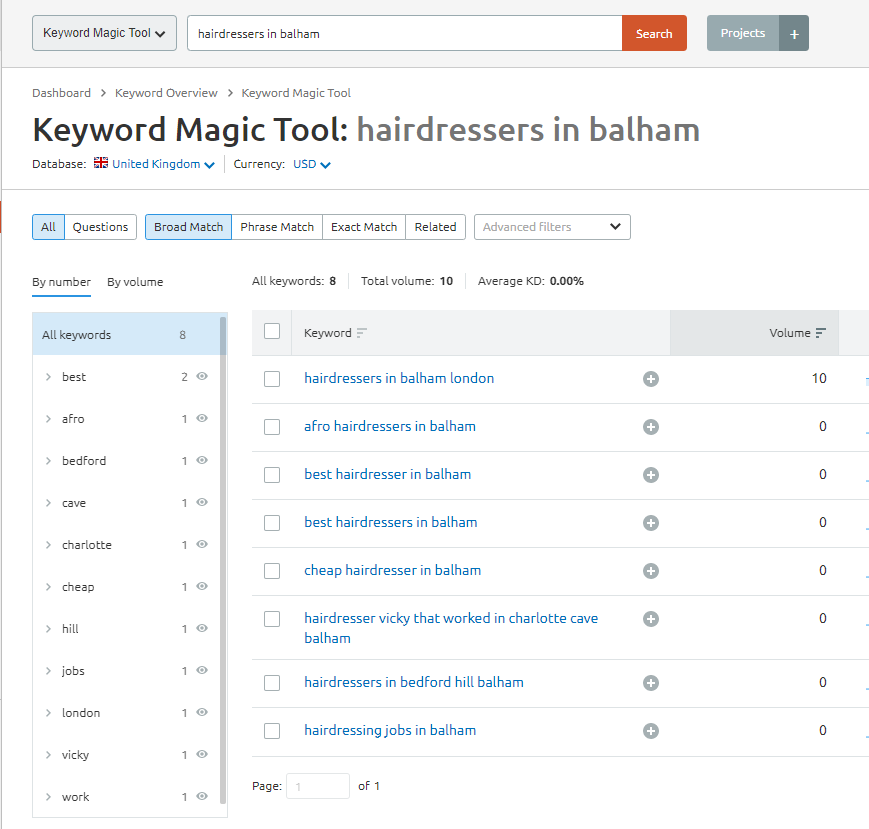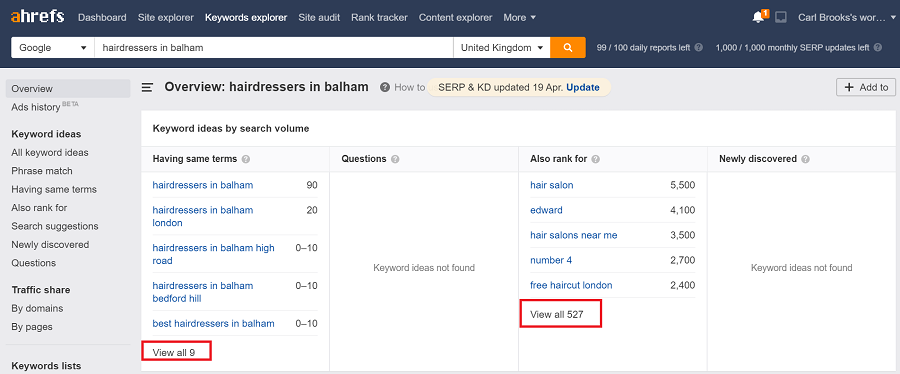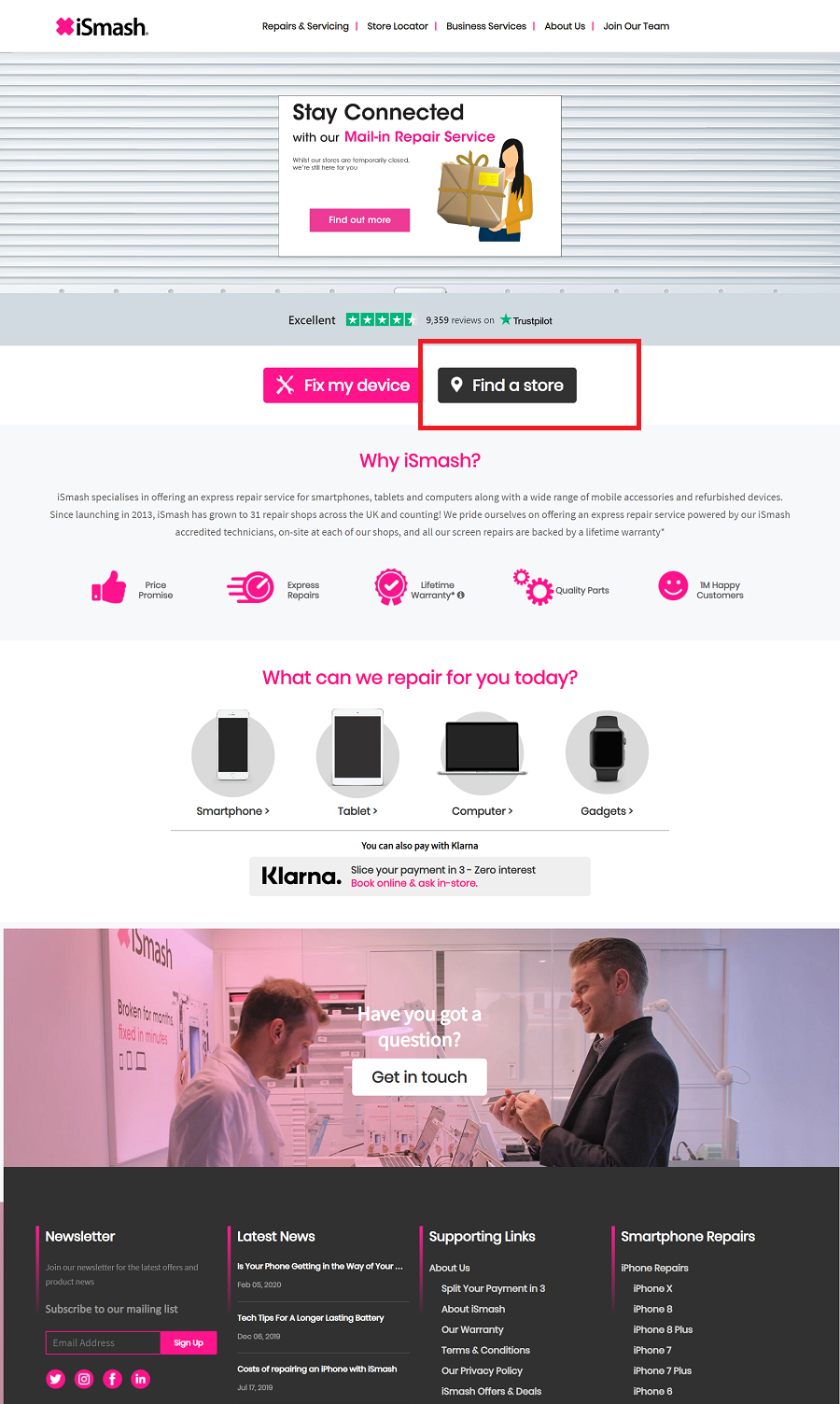Local SEO should be a key pillar of your SEO strategy. If you are a Brick and mortar business or business without an address (eg home-based business or independent service provider), local SEO will be crucial for online visibility. Local SEO optimises your business for people searching from nearby locations. Both small businesses and large retailers benefit from undertaking an effective local business SEO campaign as this enables a business to appear on page 1 of Google SERPs, both in “local packs” and “organic listings”. Some examples of local businesses include restaurants, lawyers, dentists, spas and salons, handymen, plumbers etc.
You need a proper local SEO strategy to improve your visibility on both the local pack and organic SERPs. So, let’s look at an example of a local search query. A search for ‘plumbers near me’ or ‘best plumbers in queen street’ signals a clear buying intent relevant to that location. This query would return local results based on the user’s location or the location for which the user is looking for that service or product. So, when you search for ‘plumber near me’, you will see a similar result as below on Google – Local pack above organic results. The Local pack always appears above all organic results, which gives local businesses an edge over organic results

Because the local pack is right at the top occupying a prime real estate of the SERP, optimising for local does not only benefit small businesses but also benefits large multi-location retailers that require a local presence in different geographical locations. Let’s look at the steps to optimise your local business to improve your visibility online.
Local SEO Guide to Improve Your Local Search Rankings
The importance of local SEO will continue to rise because of the continued rise in the usage of mobile devices. Google identifies Relevance, Proximity and Prominence as the key local ranking factors. Let’s look at the Local SEO checklist to manage local SEO for your brand;
- Step 1: Create your Local Keyword List
- Step 2: Pick a location to prioritise local SEO.
- Step 3: Create local landing pages to optimise for location search terms in SERPs.
- Step 4: Add Local schema markup to your local landing pages.
- Step 5: Set up a profile on Google My Business.
- Step 6: Build Accurate Local Citations for your business.
- Step 7: Local Link Building from Authoritative Websites.
- Step 8: Generate Reviews to Build Credibility.
- Local SEO Tools
Step 1: Create your Local Keyword List
The first step is to identify a list of local keywords for which you want to be found. Whether you are a sole trader or small business operating in a single location or a large business operating from many locations, you need to start by performing keyword research.
Let’s take a look at how to create a local keyword list in this step. First, you must prepare a list of seed keywords. This seed list is essentially a list of all the services you provide and all the locations you operate from or service to. This will form the basis of your targeted keyword list. Secondly, you need to expand each of your seed keywords (service + location combination) using keyword research tools such as SEMRush, Ahrefs, Spyfu, and Google Autosuggest to generate your targeted local keywords list.
Assuming you own a hairdressing business based in Balham and you want to optimise it for local search to target Balham and surrounding areas such as Tooting, Clapham etc to increase footfall and ultimately drive business, let’s look at the keyword research process;
I’ll show you the steps required for one seed keyword – ‘hairdressers in Balham’. In this case ‘hairdressers’ is the service and ‘Balham’ is the location. You can repeat the steps for all your seed keywords.
- I would recommend using Google’s autosuggest feature as the first step to get a list of keyword ideas from their autocomplete suggestions that appear when you start to type a search term.

As you can see from the suggestions shown above, there are some useful keyword modifiers you can optimise your page for such as ‘best’, ‘recommended’, ‘good’ etc that people use on Google for your business type.
-
- Next, you could use 3rd party tools such as SEMRush ‘s keyword magic tool on Ahref’s keyword explorer tool to expand your seed keywords by entering your seed keywords one by one of these tools. Also, use Google keyword planner for some keyword ideas.


- Next, you could use 3rd party tools such as SEMRush ‘s keyword magic tool on Ahref’s keyword explorer tool to expand your seed keywords by entering your seed keywords one by one of these tools. Also, use Google keyword planner for some keyword ideas.
- Export from all tools, de-dupe the list and repeat this process for all your seed keywords. This will cover all your services and locations you operate in.
It is important to undertake thorough keyword research to understand the size of the local search opportunity.
Step 2: Pick a location to prioritise local SEO
Using the keyword search volumes from the previous step to dictate what location pages to optimise with good quality content and implementing a clear inbound linking strategy is a key component of your local SEO strategy. For example: if ‘hairdressers in Tooting’ gets more searches than ‘hairdressers in Balham’, prioritise optimisation for the Tooting location over Balham.
In this example below, when you search for ‘bike repair in oxford street’, you are presented with a Google SERP showing a mixture of result types – a local pack, directory results, location-specific landing pages and organic results. Interesting to see some of the directory sites in the top positions as Google deems them as sites with strong authority that produce a lot of useful content that potential customers are looking for. So, it becomes important to build consistent citations for your business as explained in Step 5.

Step 3: Create local landing pages to optimise for location search terms in SERPs.
Create location-specific landing pages for each of the locations you operate from to optimise for Google SERPs. When designing your local landing page, it is important to treat it like any other page and fully optimise it to have visibility for local search queries.
Local Store Landing Page Optimization Best Practices
- Feature keywords with the highest local searches in both page titles and meta descriptions. Use city, town or street names in your title tags, URLs, heading tags, image file names and alt text, meta descriptions and page copy.
- Follow a clean header tag structure and optimise your page headings.
- Add unique content to your local pages. This will not only benefit the user but will also help to target local keywords for ranking.
- Some businesses showcase store-specific reviews and testimonials on their location landing pages. This is a great way of generating unique content by leveraging on generated content.
- Add all the basic information specific to your location on your landing pages such as the name, address, phone number, hours of operation, an interactive map with driving directions, store-specific offers, store events, a summary list of top brands, goods and/or services offered at that location, video content, indoor/outdoor imagery of the specific store, parking information and more.
- Optimise the internal linking architecture to increase the inbound links to your local landing pages. Your local internal linking strategy may vary depending on whether you are a single-location or a multi-location business. If you are a single-location business, you should use the homepage to target the main service/link directly to the landing page. If you are a multi-location business, you should link to the store finder page from your homepage. Also, horizontal linking to other nearby store pages from a local store locator landing page can further optimise your internal link structure.

 Macy’s store locator pages are one of the best store locator pages to take inspiration from.
Macy’s store locator pages are one of the best store locator pages to take inspiration from.
Whether you are SME, who operates from a few locations or a large business or a retailer with multiple outlets across different geographical areas, it is very important that your site’s information architecture is designed in such a way that It is fully optimised to have visibility for local search queries.
Step 4: Add Local schema markup to your local landing pages
Take advantage of local schema markup. The local schema markup data helps give Google a better understanding of the local landing page. Add local business schema markup to all your local landing pages. Use Google’s Structured data testing tool to validate your markup code. Schema markup allows search engines to display valuable information such as site links, reviews & testimonials, prices, business operating hours, hours required to perform a task (recipes) or even entire restaurant menus in the SERPs. This additional information will help your SERP listing pop out resulting in significantly increasing your click-through rates from the SERPs. While it can be used to improve the appearance of your search result, it does not impact SEO rankings.
You can take advantage of business-specific schema to make your local results look better on SERPs. Example: If you own a bakery, you can implement Schema.org/bakery. Each schema contains several sub-properties such as opening hours, name of the business, phone number, area served, etc.
Step 5: Set up a profile on Google My Business.
Google My Business (formerly known as Google Places and Google Local) is the starting point of Local SEO. It is a free tool for businesses and organizations to manage and maintain accurate information about your business online. Without Google My Business, you won’t be able to get a listing on the Google local pack or map listings which are displayed for a vast majority of locational search queries. To set up an account on GMB, click here.
If you own a business and it hasn’t been claimed, you must claim it. You can provide Google with information such as website URL, business address, local phone number (must match the number on your website), opening hours, business description, photos and videos and more via your GMB account for all your business locations. The more information you provide the better optimised you are for local queries. With some business types, you can provide additional info such as a menu for restaurants.
With a GMB account, you get a dashboard to view the top-level performance of your business in local results. You can use the dashboard to
- Update your business NAP (business name, address, phone number), opening hours etc.
- View insights to understand how users are landing on your business listing. View actions that were taken by the user once they land on your listing.
- Photos of your products, your shopfront or even yourself.
- Create Google posts to feature business updates, offers, events and product info.
- Select the most relevant category associations for your business.
- Interact with your customers by answering questions and responding to reviews.
- Businesses can add or edit attributes specific to their business via the “Add Attributes” under the “info” section. For example, Restaurants can add attributes such as“curbside pickup”, “no contact delivery”, and “dine-in”.
When you create a Google My Business account, it connects your local business with Google Maps. You can learn the ins and outs of Google My Business through the online training provided by Google for free to set up your free GMB listing.
Google My Business support: https://twitter.com/GoogleMyBiz / https://www.facebook.com/
GoogleMyBusiness/
If you truly want to optimize your Local SEO, it is important that you not only look at GMB but also optimize your search engine listing for Bing Places, Apple Maps, Yelp and Tripadvisor
Step 6: Build Accurate Local Citations for your business.
As part of your local SEO strategy, it is important to build citations for your business. Local SEO citations are “mentions” of your local business on other sites (especially directory sites). If your NAP is mentioned on another site, it is considered a citation even if there is no link back to your website.
When it comes to evaluating local SEO rankings, Google would evaluate the relevance, consistency and authority of the citation source. Citation signals are among the top-ranking factors for local SEO. Hence, it’s important to actively manage and keep your listing information (such as the NAP, opening hours etc) accurate across all your citations to improve your local rankings. The more quality citations a local business website has across the web, the better it is for your visibility.
 Citations Listing Management: Image Source: Yext
Citations Listing Management: Image Source: Yext
You should proactively monitor and maintain accurate information across all major local platforms/citation sources. There should be only one version of your NAP info across all citations. Incorrect NAP info sends a bad signal to Google. Having consistent information is not only important to improve local SEO visibility in organic results and the local pack but also helps build consumer trust.
If you are a large eCommerce retailer or business serving multiple locations, it becomes a daunting task to manage your business listings across hundreds of platforms, business directories, maps, social media platforms and more. There are local SEO tools or local management companies such as YEXT, Uberall, Partoo etc that provide services such as listings management, local page management, duplicate listings suppression, review management and other local services.
Citations are also important because search engines acquire important business-related information from them. They become all the more crucial for small independent business owners, such as handymen, plumbers and electricians who don’t have well-optimized websites. You can use Moz local to do a quick check of the top 15 citation sources to check your online presence.
Step 7: Local Link Building from Authoritative Websites
Just like how backlinks are crucial for traditional SEO, local links are what make the difference to achieve success over other local competitors to improve local rankings. Ensure you point your links to the local landing page rather than all to the homepage. Below are some ideas for securing quality backlinks for your local business;
- Get links from industry-related sites or other businesses in your local area.
- Getting reviewed or featured on regional media, local business directories or local newspaper sites.
- The London Chamber of Commerce
- Outreach to local businesses who offer complimentary service and are open to reciprocal partnership ideas.
- Nominate your business for local awards.
- Local volunteer opportunities/sponsorships for charities in your area and local events (or even sports teams).
- Host or be a part of Local community events and meetups.
- Evaluate the backlink profile of both your direct and indirect local businesses within your area to generate some additional link ideas.
- Guest posts on local business sites.
- Get listed on the local resources page of the businesses within your area.
Backlinks, content and Google RankBrain are the top 3 ranking factors for Google. If your local business has a strong backlink profile, it is more likely to appear in the local pack. Backlinks not only improve your rankings, but they also improve your business visibility and exposure to the local customer base.
Step 8: Generate Reviews to Build Credibility
When it comes to Local SEO, building credibility with reviews and online testimonials is an extremely
important aspect. The higher the average rating, the better it is for your local business’s search engine rankings and customer conversions. According to research, 92% of customers read online reviews before
making a purchase. Good reviews can also lead to viral word-of-mouth marketing that, in turn, leads to even more exposure, higher credibility, and more customers.
Review Generation Do’s and Don’ts
- Don’t ignore negative reviews. Do reply to all reviews and handle negative reviews, especially with care.
- Don’t post or pay for fake reviews.
- Don’t ask employees to leave reviews.
- Don’t incentivize.
- Don’t just focus on Google reviews. Don’t forget Yelp, Bing Places etc.
It is not just the amount of positive reviews you get. The frequency by which you get online reviews also plays an important part. Consistency is key here, so keep working to get more reviews on a continuous basis by sharing your review link with everyone using the White Spark Google Review Link Generator.
Local SEO Tools
If you have a business with 100’s of store locations, managing your local SEO properties manually is not going to be easy. You can use the below tools to scale your local SEO efforts;
How to Quickly Check if your Local SEO Strategy is Working?
If you want to perform some quick local visibility checks of your business, here’s what you can do;
- To check your ranking in a specific city, Add the‘ &near=cityname’ parameter to your Google search URL alongside the “q=” parameter. Example: To check the local pack for ‘plumbers’ in Balham visit, https://www.google.com/search?q=plumbers&near=balham
- Use the Google Ads Preview tool to check the local SERP for a keyword, location and device combination.

There are plenty of other ways to check Google search results for different locations. It is not really feasible for me to list all the methods in this post.
No time to deal with Local SEO? I provide Freelance SEO consultant services. Contact me today to discuss how I can help.

